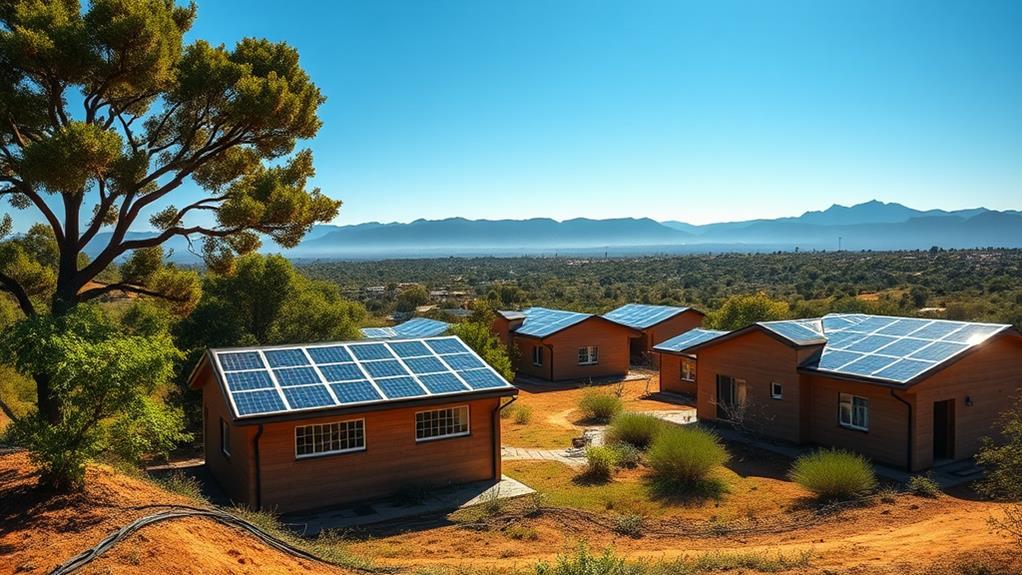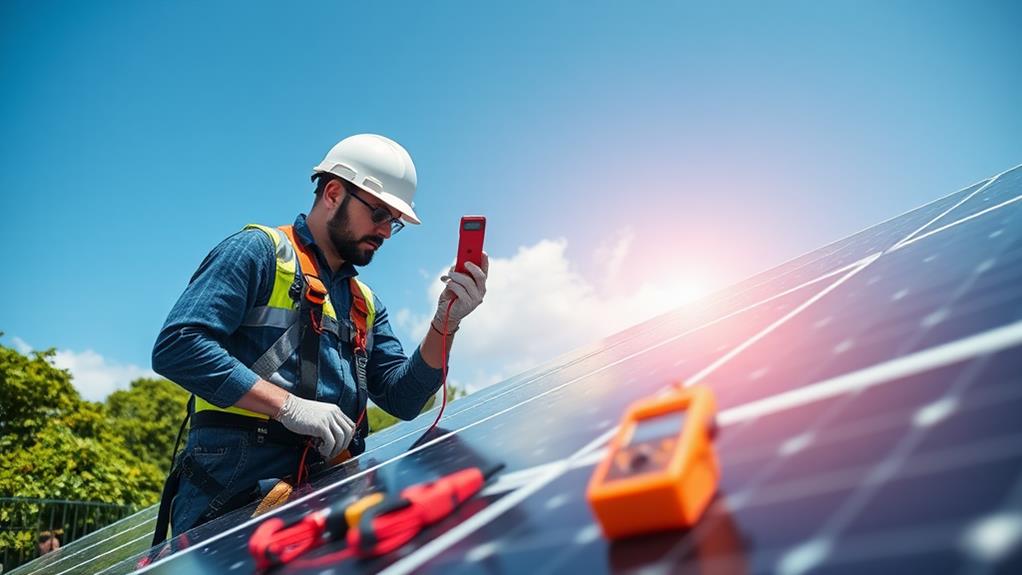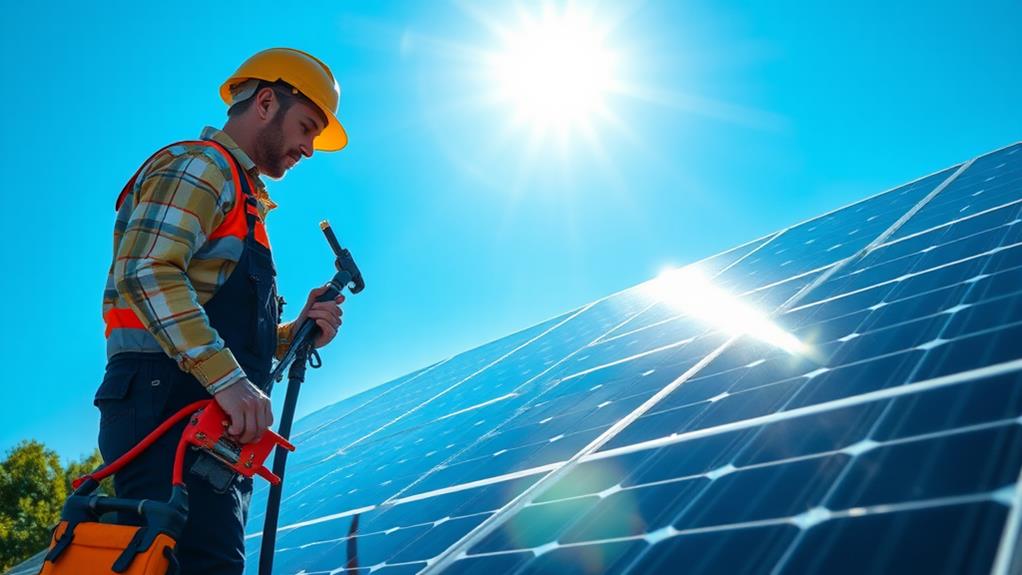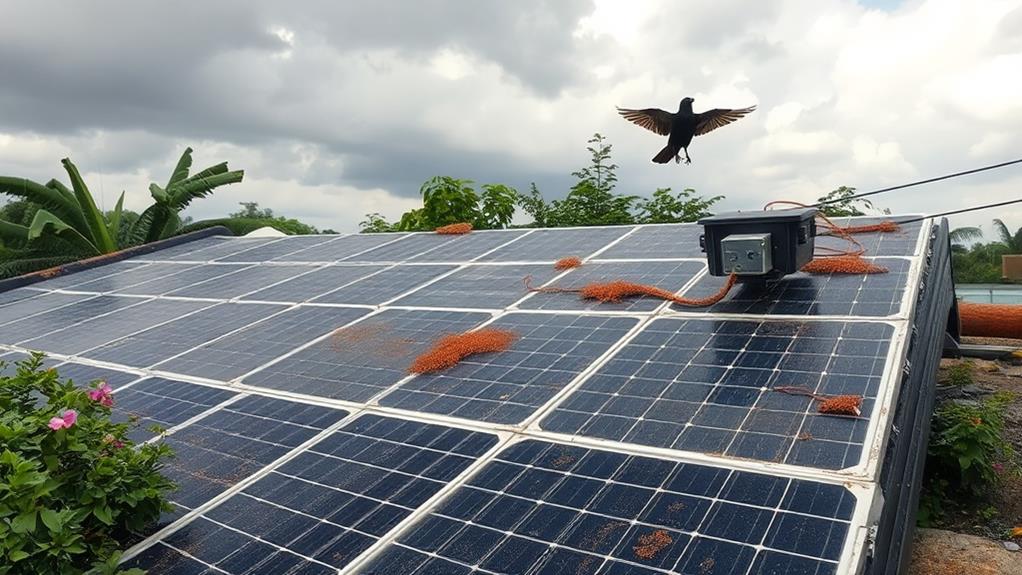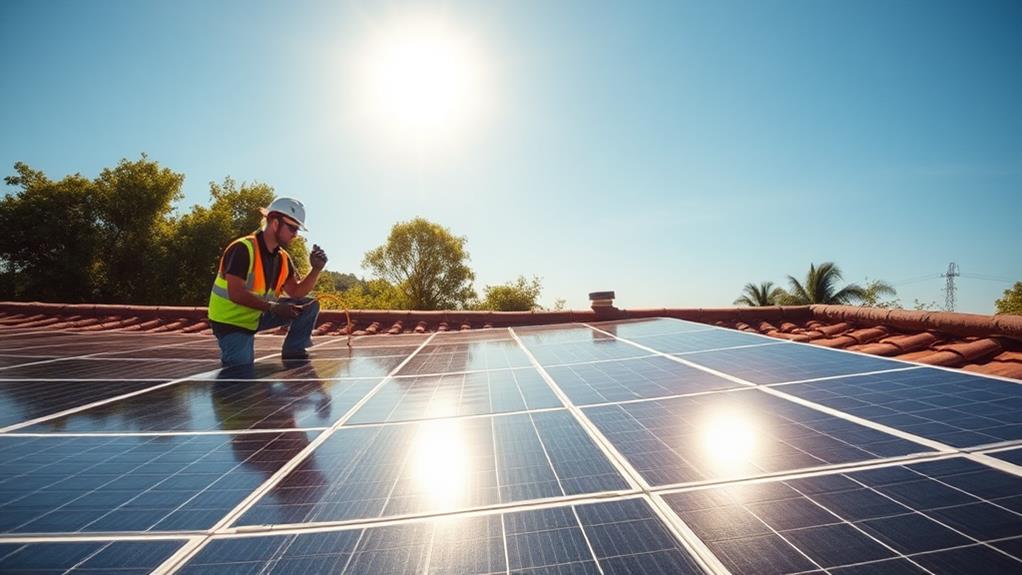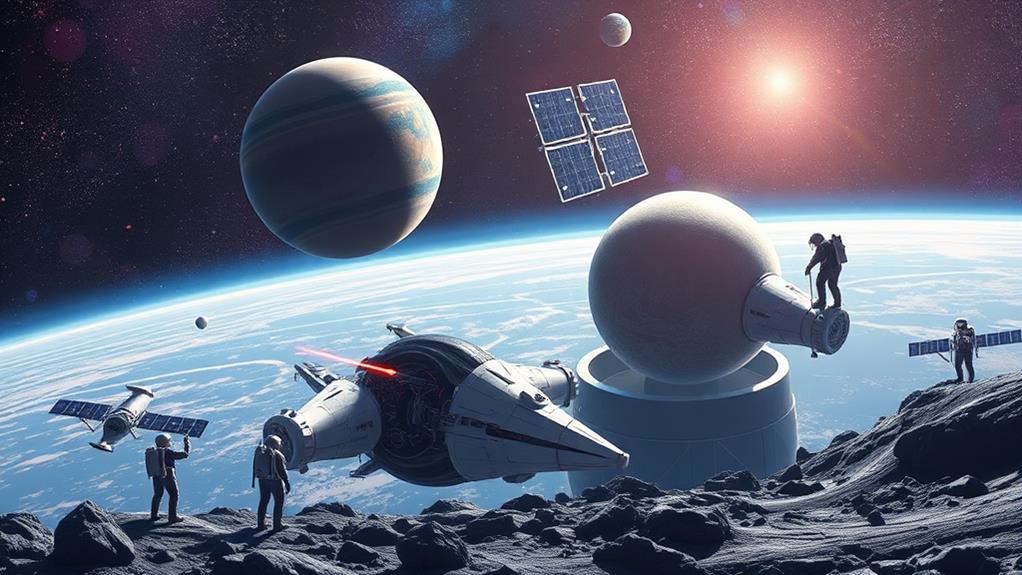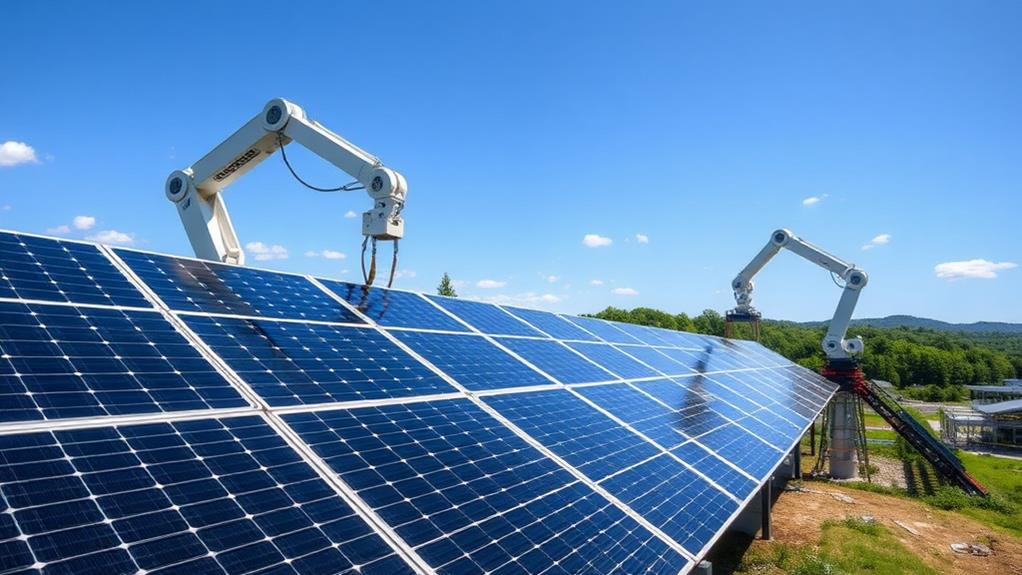In South Africa, we must follow the SANS 10142-1 regulations to safely ground solar systems, reducing risks such as electric shocks and fires. Proper grounding involves connecting PV panels with earth cables and conducting routine inspections to maintain compliance. Premium grounding rods, such as DEHN products, improve system safety. For additional security, proper placement of lightning rods and stable grounding guarantee energy is safely dispersed, minimizing surge risks. Regular upkeep of these elements is essential for ongoing reliability. By grasping these guidelines, we can confirm adherence and discover more about improving system safety and efficiency.
Key Takeaways
- Adherence to SANS 10142-1 regulations is crucial for solar PV earthing systems in South Africa.
- Proper integration of PV panels with earth wires reduces risks of electric shock and fires.
- Regular inspection and maintenance ensure compliance with earthing standards and system safety.
- High-quality earthing products, like DEHN rods, contribute to effective system grounding.
- Meeting legal obligations by complying with regulations safeguards communities and ensures quality standards.
Earthing Standards Overview
In South Africa, adherence to SANS 10142-1 regulations is crucial for earthing systems in solar PV installations. These regulations are essential for ensuring the safety and reliability of solar energy systems. Proper integration of PV panels with earth wires reduces the risk of electric shock and potential fires. Grounding systems protect property and the environment.
Understanding the aspects of earthing systems is fundamental. The SANS 10142-1 guidelines provide a framework for effective implementation. Regular inspection and maintenance ensure installations remain compliant and safe. This responsibility connects us as we work towards sustainable energy solutions.
Non-compliance with these regulations can result in penalties or system shutdowns. Staying informed and diligent contributes to a community that values safety and innovation. Ensuring our PV panels aren't just an investment in energy efficiency but also reflect our commitment to safety, adhering to SANS 10142-1 standards, is vital.
For example, the use of high-quality earthing rods like those manufactured by DEHN provides effective grounding. Investing in reliable products contributes to the safety and efficiency of the entire solar system.
Lightning Protection Strategies
Let's investigate how we can improve the safety of solar systems by focusing on effective lightning rod placement and risk mitigation techniques.
We grasp that positioning lightning rods accurately is essential to safeguarding installations, especially on taller metal structures that naturally attract strikes.
Effective Lightning Rod Placement
Effective lightning rod placement is essential for protecting solar systems from lightning damage. Placing lightning rods at the highest point of a structure is crucial. This strategic placement redirects potential lightning strikes away from valuable solar panels, creating a protective zone that shields the system from harm. Ensuring that lightning rods are securely grounded enhances their ability to effectively dissipate lightning strikes, safeguarding installations.
Designing a lightning protection system requires attention to the proper spacing between lightning rods. The right distance between them is vital to forming an adequate protective zone that envelops the solar system. Multiple lightning rods around the installation can further strengthen this protection, offering peace of mind during thunderstorms.
Regular inspection and maintenance are equally important. Routinely checking the integrity of lightning protection guarantees its continued effectiveness. Prioritising these practices ensures solar systems remain secure and efficient, fostering a sense of safety and community within our shared solar journey.
Risk Mitigation Techniques
Protecting solar systems from lightning threats requires effective risk mitigation techniques. Collaborating ensures solar installations are both safe and compliant with local regulations. A key strategy is installing lightning rods, which protect solar systems by intercepting direct strikes. These rods channel electrical energy safely into the earth, minimising potential damage.
Taller structures around installations can act as lightning attractors, diverting strikes away from solar panels. This simple strategy enhances system resilience.
Moreover, a comprehensive lightning protection system significantly reduces the impact of lightning-induced surges on the solar setup, ensuring excess energy is safely redirected and dissipated.
Proper earthing is crucial. Ensuring that both the system and surrounding structures are well-grounded allows for the safe dissipation of lightning energy into the ground, minimising risks.
Adhering to local regulations and guidelines for lightning protection is essential. Following these rules creates a safer environment for solar systems and reinforces a commitment to responsible energy solutions.
Installation Safety Practices
As we investigate installation safety practices, it's important to focus on proper earthing techniques. Using galvanized roof hooks, clamps, and connecting earth wires directly to the building structure guarantees a secure setup.
Let's not forget the significance of regular inspections to maintain the system's long-term safety and performance.
Proper Earthing Techniques
Proper earthing techniques play an essential role in ensuring the safety and efficiency of solar installations. As a community invested in sustainable energy, connecting PV panels and rails directly to earth spikes is crucial. This connection protects both the system and its users from electrical faults. Galvanised steel rails may present complications due to galvanic corrosion. Selecting and installing components with care helps overcome these challenges.
Grounding effectiveness improves when earth wires from each panel connect to the building structure. This step reinforces our commitment to safety and performance. Typically, 6 mm or 10 mm earth wires are used in solar installations, which are standard for effective grounding. Regular inspection of these connections is vital for maintaining long-term safety and performance.
Specific examples and product recommendations:
Consider using the Armoured Earth Cable, which is designed for enhanced durability and protection against environmental factors, priced at approximately ZAR 50 per metre.
Additionally, the Copper Earth Rod, priced at around ZAR 120, offers excellent conductivity and longevity, ensuring a reliable earthing connection.
Safety Component Essentials
Ensuring safety in solar system installations isn't just important; it's essential. We all aim to guarantee our solar systems are efficient and secure. Key components, such as isolators, fuses, and over-voltage protectors, play a crucial role in this aspect. These components manage peak currents, often around 11.5 amps, typical in solar setups with series wiring. Incorporating these elements safeguards systems from potential electrical hazards.
Isolators provide a safe means to disconnect power for maintenance, ensuring risk-free work conditions. Fuses act as frontline defenders, severing the circuit if the current exceeds safe levels. Over-voltage protectors shield equipment from unexpected voltage spikes, maintaining system integrity.
Securely attaching earth clamps to each panel frame is vital for effective earthing, protecting against electrical faults. As responsible members of the solar community, awareness of potential corrosion issues between different metal types is crucial, ensuring long-term safety and reliability.
For example, using stainless steel fasteners can prevent corrosion when connecting aluminium frames. These practices enhance the safety and inclusivity of solar ventures.
Regular Inspection Importance
While the initial setup of solar systems is often the focus, routine examination of earthing connections remains crucial. As a community committed to sustainable energy, ensuring our systems operate efficiently and safely holds great importance. Conducting periodic inspections allows us to identify issues such as corrosion, loose connections, or damage that could compromise the integrity of our earthing system. These checks serve as our primary line of defence against potential electrical faults and system malfunctions.
Integrating inspections into regular maintenance schedules, particularly after severe weather, enhances the longevity and reliability of our solar installations. It transcends merely meeting regulatory requirements; it safeguards our investments and the community's well-being. Maintaining detailed records of these examinations enables us to monitor system conditions, ensuring adherence and fostering a sense of responsibility among us.
Prioritising regular inspections reinforces our commitment to a safer, more sustainable future, aligned with the shared goal of dependable solar energy for all.
For high-quality inspections, consider using products like the Fluke 1664 FC Multifunction Installation Tester, which offers comprehensive testing capabilities. Such tools ensure thorough assessments, crucial for effective maintenance and safety assurance.
Compliance With SANS Regulations
Adhering to SANS 10142-1 regulations is essential for those involved in solar system installations in South Africa. Compliance ensures that best practices for effective earthing are followed, not only meeting legal obligations but also safeguarding communities from potential hazards like electric shocks and fire risks.
Following SANS guidelines commits to the safety and longevity of solar systems. These standards set the benchmark for installation quality, ensuring each system operates safely and efficiently over time. Being part of a community that values safety and reliability reinforces this commitment.
Ignoring compliance leads to serious consequences, including penalties and potential system shutdowns. Responsible stakeholders must prioritise these standards in their work, creating a safer environment for everyone involved and contributing to sustainable energy solutions. Upholding these standards ensures solar initiatives continue to operate brightly and safely for years.
Licensing and Permits Process
Navigating the licensing and permits process for solar system installations in South Africa ensures compliance and operational success. Understanding the requirements is crucial. Depending on the size and power output of your PV array, a generation licence from NERSA might be required. This step guarantees that your solar system meets all safety and regulatory standards, laying the groundwork for energy independence.
Local municipalities play a significant role. They often demand building permits for solar installations, necessitating detailed plans and budgeting for associated fees. These permits are essential for maintaining compliance and avoiding potential insurance or legal complications.
Securing a Certificate of Compliance (COC) from qualified professionals completes the process. This certificate confirms that every component, from the earth spike to the entire PV array, adheres to all necessary regulations. Following these steps means not just installing a solar system, but joining a community committed to safe and sustainable energy solutions.
Incentives and Environmental Impact
As we engage with the solar installation process in South Africa, incentives and environmental impacts accompany this venture. Embracing solar panels isn't just about tapping into a sustainable power source; it's about being part of a community committed to greener living and energy independence.
The South African government provides incentives like feed-in tariffs, encouraging contributions of solar energy to the power grid, which supports the broader adoption of renewable energy.
However, with larger solar installations, potential environmental effects must be considered. An environmental impact assessment (EIA) may be necessary to ensure these projects align with sustainability goals. Conducting an EIA verifies compliance with environmental regulations, promoting responsible development. This process safeguards our local ecosystems and reinforces dedication to sustainable practices.
Understanding both incentives and EIAs is vital for advancing successful and environmentally friendly solar projects. These elements foster the growth of renewable energy and help protect the environment for future generations. Together, a positive impact can be driven, paving the way for a cleaner, more sustainable energy future in South Africa.
Conclusion
In exploring solar system earthing in South Africa, we have identified important standards and strategies to ensure safety and compliance. By understanding earthing and lightning protection, focusing on installation safety, and following SANS regulations, we can effectively navigate the solar landscape. It is essential to obtain the correct licences and permits while also considering incentives and environmental impacts. Together, we are moving towards a sustainable future powered by solar energy.
If you have any questions about our products or services, please contact Deo Solar. We provide a range of products including Rail-Less Solar Brackets, End Spacers, Structural Brackets, Ground Mounted Solar Systems, Corrugated Brackets, and Earthing Plates. Our services include the DeoSizer Tool, Evaluation and Design, Maintenance and Support, and Solar Installations. We are here to assist you with all your solar needs. Let's work together for a brighter future!

